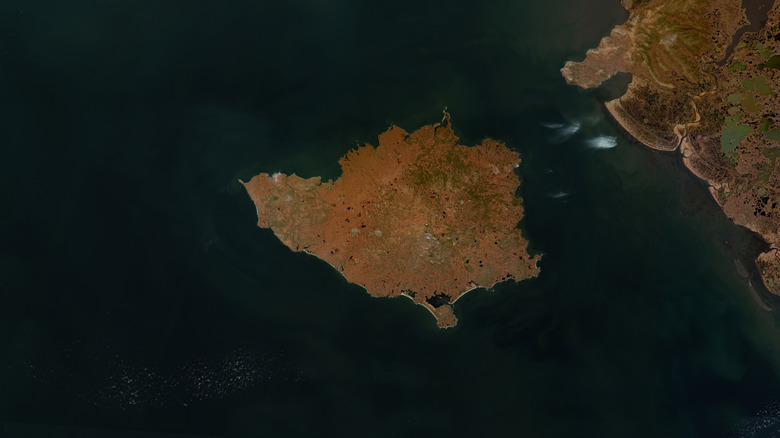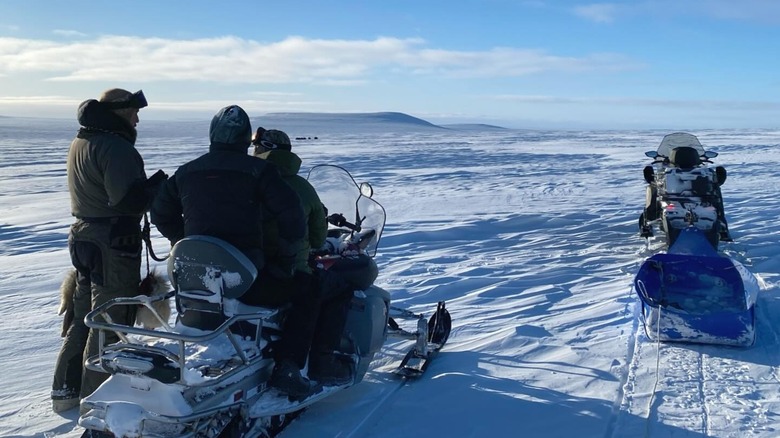One Of The Largest Islands In America Offers Opportunities To View Wildlife, Hunt, And Hike
If getting away from the hustle and bustle of civilization is your idea of a nice time, look no further than Nunivak Island. Sat in the Bering Sea, about 30 miles offshore from the Yukon River Delta, and boasting that wanderlust-inducing blend of amazing wildlife and epic terrain, it's what Alaskan adventure dreams are made of. Just like the super remote and breathtaking Bering Land Bridge National Preserve, this destination feels tailor-made for intrepid travelers who love nothing more than hiking through Mother Nature's most otherworldly creations.
Just over 1,600 square miles in size, the United States' eighth-largest island was formed out of a volcanic plateau that rises more than 500 feet above sea level. With evidence of volcanoes first erupting here some 6.1 million years ago, there's arguably no better place in America to don your "Geology Rocks" t-shirt. Just stuff it in the most rugged backpack you own, alongside appropriate outdoor clothing and footwear, and brace yourself for a taste of the wild side.
Due to its location, getting to Nunivak is anything but easy. Once you lay your eyes on this destination in real life, though, you'll realize that the challenging journey was well worth the effort. The primary way to reach the island is by flying from Bethel, Alaska, to the extremely basic Mekoryuk Airport. Little more than a gravel airstrip beaten into the tundra, and often flanked by snowbanks and ice, there's no real terminal building to speak of once you land. JFK or LAX it is not. The initial flight to Bethel is possible out of Anchorage. With Nunivak lacking a regular ferry service, taking the aerial route is far and away your best option. Back on terra firma, the island's local guides and residents can help with the rest.
Partake in the hunting heritage on Nunivak Island
From prehistoric times until the late 1800s, wild caribou roamed freely on the island. Their population was once estimated to be 25,000, but by 1904 a combination of overhunting and starvation during severe winters had wiped them out. In the 1920s, two brothers, Alfred and Carl J. Lomen, had great success in introducing reindeers to the island and crossbreeding them with caribou. Their company ruled the U.S. export market for reindeer meat and skins. In 1929, the stock market crashed and the subsequent Great Depression reduced demand. Then an executive order established the Nunivak Island Reservation. Its aim was to reestablish the muskox as a native animal of Alaska, and also create a preserve and breeding ground for native birds and wild game.
Muskox, with the help of the United States Fish and Wildlife Service, successfully returned to Nunivak Island in 1935. Thought to be survivors of the Pleistocene era, muskox numbers dwindled but today this remote island is home to just over 500 of them. Hunting season is split into two periods. The fall hunt kicks off at the start of August and runs until the end of September. The second hunt stretches across winter and spring, from the middle of January to the end of March.
Needless to say, the weather in these parts can get pretty extreme in either season, so pack appropriately. The number of available permits varies depending on the Nunivak Island muskox population. Because of the island's lack of predators, hunters play a vital role in keeping the population at sustainable levels. This is why any hunter not planning on using their permit should contact the Alaska Department of Fish and Game office in Bethel as soon as possible to have it reassigned.
Discover other ways to play outdoors on Nunivak Island
You don't need to be a hunting enthusiast to get something out of a visit to Nunivak Island. Ever since 1940, when Congress renamed the Nunivak Island Reservation as the Nunivak Island National Wildlife Refuge, the challenge of travel to this outdoorsy haven has made it an increasingly tempting option for anyone looking to cut themselves off from modern living for a bit. Its incorporation into the Yukon Delta National Wildlife Refuge in 1980 has only increased its credentials on this score.
Birdwatchers heading to Nunivak should make straight for the island's steep cliffs on the southwest coast. It's a corner of the region that hosts up to 1 million seabirds, so prepare yourself for a whole load of flapping wings and don't forget those binoculars. Named after Captain Adolph Karlovich Etolin, a 19th-century Russian explorer, Cape Etolin on the island's northern coast is another excellent spot for birdwatching and wildlife observation. Be sure to pop it on your itinerary alongside some Nunivak tundra hiking and fishing. While you're here, there's also opportunities to see unique seasonal wildflowers in their natural habitat and gaze out onto the Bering Sea like a songwriter posing for their album cover. Given the challenges getting here, Nunivak is even more secluded than Alaska's least-crowded national park, Kobuk Valley.
Due to Nunivak's limited road network, car rentals are not an option. What you can do instead, though, is hire a local expert in Mekoryuk and get shown about the island on ATVs. Guided boat tours are also popular. If a trip to Nunivak has you hungry for similar off-the-grid adventures in Alaska, take your next voyage to uncrowded Hope on the Kenai Peninsula.


